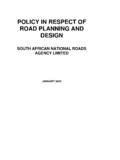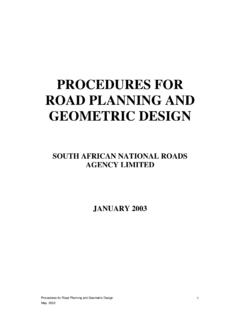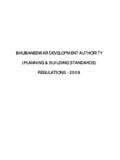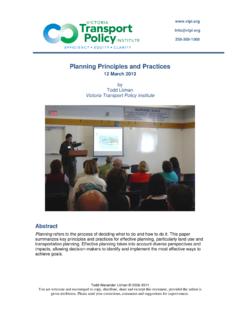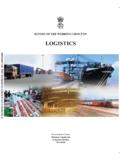Transcription of LIDAR SURVEYS FOR ROAD DESIGN IN THAILAND KEY WORDS: ABSTRACT
1 25th ACRS 2004 Chiang Mai, THAILAND 167 New Generation of Sensors and Applications LIDAR SURVEYS FOR road DESIGN IN THAILAND Mr. Chanchai Techashongs, Department of Highway, Bangkok, THAILAND ; Lek Chudasuta, Royal Thai survey Department, Bangkok, THAILAND ; Dr. Phisan Santitamnont, Chulalongkorn University, Bangkok, THAILAND , Dr. Rejean Simard, Lasermap Asia , Kuala Lumpur, Malaysia, Mr. Pierre Belanger, GPR Consultants Lasermap, Boisbriand, Canada, KEY WORDS: LIDAR , DEM, road DESIGN , Pilot project, THAILAND , NBIA ABSTRACT Concerned with environmental and drainage problems associated with road infrastructure that can greatly affect the populations located in its vicinity, the Department of Highways of THAILAND (DOH) is looking for ways to minimize the impact of new road construction and maintenance.
2 In particular, roads and highways often need to be built in high-risk and sensitive areas such as hilly, unstable terrain. LIDAR technology is of great interest to DOH as its use can make them save enormous amounts of time and money by providing highly precise elevation data in all kinds of environments including harsh and rugged areas. Generally, survey and DESIGN for a common highway requires about 7-8 months for completion while major projects require at least 12 months. Among the many technological improvements introduced over the past years, GIS has been adopted to a certain extent to enhance survey and DESIGN capability development. The integration of LIDAR -produced digital elevation models into their existing GIS databases will greatly improve DOH's capacity and efficiency in highway DESIGN and associated steps.
3 LaserMap GPR Consultants of Canada is undertaking, together with DOH, Royal Thai survey Department and Chulalongkorn University, a pilot study located near the New Bangkok International Airport that aims to demonstrate the usefulness and practicality of using this kind of SURVEYS for road construction and maintenance projects in THAILAND . INTRODUCTION TO LIDAR TECHNOLOGY The relatively new LIDAR technology uses a rapidly firing laser installed in an aircraft for measuring points on the ground. The strength of the laser and its narrow, infrared beam allow it to penetrate between much of the leaves and branches and often receive a return reflection from the ground. A Global Positioning System (GPS) and an Inertial Measurement Unit (IMU), which are integral parts of the equipment, allow for continuous monitoring of the position of the aircraft and its attitude.
4 Using all of this equipment together with timing coordinated to the milli-second, the post processing of the data allows the construction of a detailed digital terrain model. The components for LIDAR technology have been around for many years. Lasers were invented in 1958. Inertial technology has been around for a long time and GPS has been around commercially for over 15 years. The challenges faced by user of LIDAR technology is putting all of these technology-components together and making them work together at the same time ensuring that it is small enough for use in an aircraft or helicopter. In reality this has only been achieved commercially in the last eight years or so. Report Documentation PageForm ApprovedOMB No. 0704-0188 Public reporting burden for the collection of information is estimated to average 1 hour per response, including the time for reviewing instructions, searching existing data sources, gathering andmaintaining the data needed, and completing and reviewing the collection of information.
5 Send comments regarding this burden estimate or any other aspect of this collection of information,including suggestions for reducing this burden, to Washington Headquarters Services, Directorate for Information Operations and Reports, 1215 Jefferson Davis Highway, Suite 1204, ArlingtonVA 22202-4302. Respondents should be aware that notwithstanding any other provision of law, no person shall be subject to a penalty for failing to comply with a collection of information if itdoes not display a currently valid OMB control number. 1. REPORT DATE NOV 2004 2. REPORT TYPE N/A 3. DATES COVERED - 4. TITLE AND SUBTITLE LIDAR SURVEYS for road DESIGN in THAILAND 5a. CONTRACT NUMBER 5b. GRANT NUMBER 5c. PROGRAM ELEMENT NUMBER 6. AUTHOR(S) 5d. PROJECT NUMBER 5e. TASK NUMBER 5f. WORK UNIT NUMBER 7. PERFORMING ORGANIZATION NAME(S) AND ADDRESS(ES) AFOSR/Asian Office of Aerospace R & D Unit 45002 APO AP 96337-5002 8.
6 PERFORMING ORGANIZATIONREPORT NUMBER 9. SPONSORING/MONITORING AGENCY NAME(S) AND ADDRESS(ES) 10. SPONSOR/MONITOR S ACRONYM(S) 11. SPONSOR/MONITOR S REPORT NUMBER(S) 12. DISTRIBUTION/AVAILABILITY STATEMENT Approved for public release, distribution unlimited 13. SUPPLEMENTARY NOTES 14. ABSTRACT 15. SUBJECT TERMS 16. SECURITY CLASSIFICATION OF: 17. LIMITATION OF ABSTRACT UU 18. NUMBEROF PAGES 6 19a. NAME OFRESPONSIBLE PERSON a. REPORT unclassified b. ABSTRACT unclassified c. THIS PAGE unclassified Standard Form 298 (Rev. 8-98) Prescribed by ANSI Std Z39-18 168 25th ACRS 2004 Chiang Mai, THAILAND New Generation of Sensors and Applications The major limiting factor for the technology has always been (and still is) the airborne GPS and it is only in the last ten years that GPS systems have become accurate enough to provide airborne positions better than 10cm.
7 With respect to the use of a GPS on board the aircraft, it is necessary to provide a link to a ground GPS station on a known control point. The ground station should be located on or close to the project site - where the aircraft is flying. This is to ensure that the aircraft record the same satellites signal as the ground station. If the ground station is located further away from the aircraft or project site then it is quite possible some of the satellites recorded by the ground station will be different from those recorded by the aircraft GPS. There are a number of other reasons also: absolute accuracy tends to diminish the further away the aircraft is from the ground station. Just to clarify a point: the accuracy of the system does not change when it is further away from the ground station; it produces data within the same relative accuracy parameters all of the time but the accuracy in relation to the absolute ground position changes when the airplane get further away from a ground station.
8 The direct result of a LIDAR survey is actually a set of points which consist of easting northing elevation obtained at the rate of 3 million points per minute (meaning a spatial density as small as 1m apart) as in the case of LIDAR models like the Optech 2050 (see Figure 1 shown left) owned by LaserMap which also produce infrared laser intensity maps. The point data are then post processed and classified into three main classes of points. The last return ground, the first return tops of vegetation or buildings or structures. Ground bare earth points can be used as a Digital Terrain Model (DTM) or converted to contours or, as we will see later, a relief model. The vegetation can be used to determine the heights of trees and using specific software calculate biomass or even expected lumber that could be cut in any specific stand.
9 In addition, the intensity feature allows the brightness of the reflected return to be recorded as a value between 0 and 255. This can then be rendered to produce an image of what is on the ground which is similar to an infrared photo. While this is not close to photographic colour quality it does allow interpretation of what is on the ground. LIDAR missions are planned very similarly to aerial photo missions. However, the LIDAR aircraft is usually flying much lower (between 1000-3000 metres) and lines are spaced closer together as the beam width is relatively narrow. LIDAR data can (and often are) used together with standard air photo or a more advanced CCD camera to produce digitally rectified images or othophotos. The DTM is used to rectify the image taking out the distortions caused by relief. This saves time and money compared to collecting a terrain model by photogrammetry.
10 However, it should be noted that it is rare that a LIDAR system and a precision aerial camera are flown at the same time, as the swath width covered by the camera is not the same as that covered by the LIDAR . But Lasermap GPR can fly LIDAR and CCD camera at the same time on the same platform. 25th ACRS 2004 Chiang Mai, THAILAND 169 New Generation of Sensors and Applications The following is a list of the main advantages of using LIDAR as a survey technology: 1. The data are all collected numerically. 2. The laser is an active sensor so it does not require specific sunlight conditions or even daylight; it can be flown under the clouds so well suited to tropical environment, 3. It is an aerial survey , so data are collected quickly and accurately and do not need field intervention. 4. The automated processing helps speed data analysis 5.










